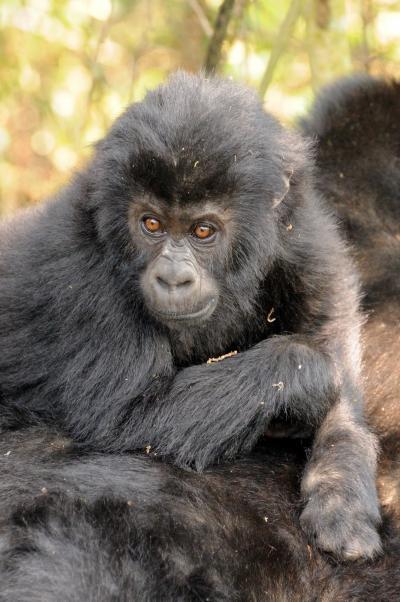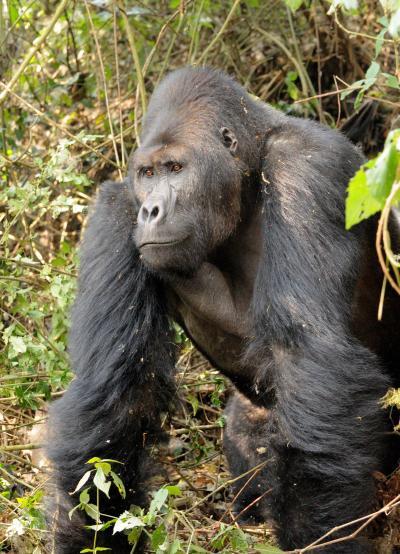A census team led by the Wildlife Conservation Society and the Insitut Congolais pour la Conservation de la Nature (ICCN) in Kahuzi-Biega National Park in the Democratic Republic of Congo today announced some encouraging news from a region plagued by warfare and insecurity: a small population of Grauer's gorillas has not only survived, but also increased since the last census.
The census, conducted late 2010 in the highland sector of Kahuzi-Biega National Park, revealed the presence of 181 individual Grauer's gorillas, up from 168 individuals detected in the same sector in 2004.
A "cousin" to the more famous mountain gorilla, the Grauer's gorilla is the largest subspecies of gorilla in the world, growing up to 500 pounds. The Grauer's gorilla (also known as the eastern lowland gorilla) is the least known subspecies, due in large part to the 15 years of insecurity in the eastern Democratic Republic of Congo. The gorilla is listed as "Endangered" on the International Union for Conservation of Nature's (IUCN's) Red List and may number fewer than 4,000 individual animals.
"We had several close calls with armed militias during the survey," said Deo Kujirakwinja, WCS's Albertine Rift Coordinator in DRC. "Thankfully, no one was hurt, and our census result is positive news for the conservation community."

A census team from the Wildlife Conservation Society and the Institut Congolais pour la Conservation de la Nature (ICCN) has made a significant finding in Kahuzi-Biega National Park in the Democratic Republic of Congo. Grauer's gorillas have increased in numbers in spite of years of insecurity in the region.
(Photo Credit: A. Plumptre/Wildlife Conservation Society.)
The census team surveyed the 600-square-kilometer highland sector of the park. The lowland sector has been largely inaccessible to researchers due to the frequent presence of militia. Census teams used nest counts—gorillas make a nest each night—along with the size of nearby dung (the size of which indicates how many adults, juveniles, and infants occur in a group) to estimate the total number of gorillas in the area.
"Given the insecurity that has been present here for so long, we were not sure what we would find," said Radar Nshuli, Chief Park Warden for Kahuzi-Biega. "We were very happy to see that all the efforts that our staff and partners have been taking are leading to a growth in the population."
The Wildlife Conservation Society's field staff have been monitoring the region's gorillas since the 1950s, when preeminent field biologist George Schaller first surveyed the distribution of what would later become classified as Grauer's and mountain gorillas. Since then, surveys have revealed that in the highland sector of Kahuzi Grauer's numbers climbed from 223 animals in the 1970s to 250 in the early 1990s before crashing to 130 in 2000 following the outbreak of civil war in the region.
"Given we were unable to survey the entire highland sector, we are hopeful that our minimum count of 181 might actually be higher than this," said Dr. Andy Plumptre, Director of WCS's Albertine Rift Program. "We hope to be able to survey some of the areas we were unable to visit in the near future."

WCS researcher Deo Kujirakwinja (in center with blue shirt) trains census participants on how to collect data on gorilla nests (at the feet of the group in this image). Researchers calculate gorilla densities using nest counts and dung piles.
(Photo Credit: A. Plumptre/Wildlife Conservation Society)
"This census finding gives us great hope for the future of the Grauer's gorilla," said Dr. James Deutsch, Director of WCS's Africa Program. "It's also a testament to the courage of our colleagues working to protect a World Heritage site in this challenging landscape."
Grauer's gorillas are one of four recognized gorilla sub-species, which also include mountain gorillas, western lowland gorillas, and Cross River gorillas. The Wildlife Conservation Society is one of the only conservation groups working to safeguard all four subspecies.

The Grauer's gorilla is the worlds largest gorilla (silverbacks such as this one can grow up to 500 pounds in weight) as well as the least known due to the insecurity of its range in the eastern Democratic Republic of Congo.
(Photo Credit: A. Plumptre/Wildlife Conservation Society)
Source: Wildlife Conservation Society